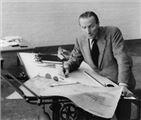Sir Alec Issigonis
22 October 1961
ISSIGONIS OF BMC
Three years ago the head of one of Britain's biggest car factories prophesied that the British Motor Corporation's minicar, which cost £10 million to put into production, would break its builders. That it has not done so and has become, one of the two chief weapons (the other is the Ford Ariglia) in the British motor industries drive toward the European market, isdue almost entirely to one man : Alexander Arnold Issigonis, chief engineer of B.M.C.
Backed by his chairman , Sir Leonard Lord, Issigonis , who calls himself a "professional blacksmith ", designed the mini at just the right time. Cars are ceasing to be status symbols and becoming necessary household chattels ; the important thing is that they should be compact and robust . He is, he says, " obsessed with compactness. " The success of the Mini's (Morris Mini minor and Austin Seven , it's the same machine) has changed his life life, though this remains a bit unusual for an executive, a director of B.M.C whose salary must be nearing five figures. He still lives in the small flat in Oxford that he has shared with his mother since 1936 and commutes between there and Birmingham. He has always been rather lonely; now with success he has become even more sure of himself.
His family were in marine engineering and shipbuilding in Turkey, but he was uprooted by the war with Greece in 1920, when he was fourteen and eventually came to Britain with his mother whom is a Bavarian; his father, a Greek who took British nationality, died soon after the family left Turkey. In London there wasn't much money and Alec Issigonis was not a good pupil at Battersea Polytechnic. He was a fair artist but he hated maths. He wanted to take a BSc at London University, but failed to matriculate. Eventually he gave it up and took the Polytechnic engineering diploma , " just as good though not the honour."
He began with a firm developing automatic transmissions, moved to Humbers as a draughtsman, and three years later, to Morris Motors at Cowley as a research engineer. This was in 1936 and he has stayed with the firm ever since except for a spell of three years in the 1950's. During the war the Morris factory became an experimental shop for combined operations, and there was not much time for car designs, despite the story that the Minor was conceived in an air raid shelter. But once the war was was over, Issigonis became a prominent member of the team that designed the Minor. Just before it went into production Issigonis decided it didn't look right. He ordered the final prototype to be sawn in half lengthways then he walked around while the halves were moved apart. Two inches was too littte; six inches too much; four inches about right. So a four inch section was put in down the middle.
"It's better to get it right before you start producing.''
Four years later in 1952, when Issigonis was chief designer at Nuffields came the merger with Austins--though it was more of a takeover with Austins the senior partners. The jockeying for power and the anonymity of a large organisation didn't go with his outsiders temperament, and he resigned. He went to Alvis and worked on something new--a compact vehicle with a big engine. But Alvis lacked the capital to tool up for a completely new car and in 1955 decided not to go ahead with the project. Then Leonard Lord invited him to join BMC.
About a year later , at the time of Suez and petrol rationing, Lord rang up and said that if Issigonis hadn't anything better to do, what about thinking of an economy car ? Issigonis started from scratch. He tried a two cylinder-engine but quickly rejected it as poor value for money But he felt that the engine and gearbox took up too much room when mounted along the length of the car, and he realised it would save space if the engine was transverse. This arrangement left 80 per cent of the car length for passenger, and was one of two big advances (the other was rubber suspension).
But the car is not " styled " in anyway , " styling ," says Issigonis, "is designing for obsolecence." He has the engineers view that something which is built to do a job has its own beauty .
Each Monday morning he leaves Oxford and drives in Mini, to Longbridge , getting to the office by 8.45 He works until 6.0 or 6.30 , then goes to a hotel in Daventry where he takes a room for three nights. His evenings are spent discussing design and aulomobile engineering with his friends , or in reading detective stories. On Thursday evening he goes back to the flat in Oxford and works at the Cowley factory on Friday. On Saturday mornings he goes shopping for his mother.
He does not have much time for hobbies, but until this year he regularly went ski-ing ; and he still makes miniature steam engines. Issigonis is now fifty-five - full of nervous energy, inquiring , and charming, making jokes against himself ; with a big head, and large, hooked nose. It is unlikely that he will design another revolutionary car ; but he will be kept busy applying the lessons of the Mini to larger models.
More news from the archive
Compare classic car insurance quotes and buy online. A friendly service offering access to a range of policies and benefits.





